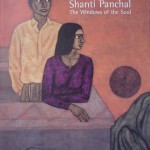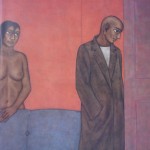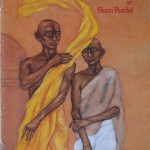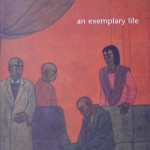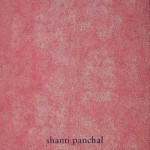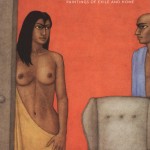Contents of British Council Mumbai Catalogue
Shanti Panchal, An Introduction
Shanti Panchal’s distinctive, strongly but subtly coloured compositions with their sometimes monumental figures are immediately recognisable and deceptively easy to assimilate. But the paintings warrant a viewing as concentrated as the work that goes into their production. Their message lies not on the surface, not in a quick reading of their figure compositions and firmly drawn figures and suspended narrative, but in the spaces between the figures, and in the intensity and depth of their colour.
Shanti Panchal holds a unique position in the British art world. Born in a Gujarat village to an uneducated family, he demonstrated this artistic talents from an early age, eventually winning a place at the JJ School of Art in Bombay. After a period of teaching in Bombay, a British Council scholarship allowed him to attend the Byam Shaw School of Art in London, and since 1980 he has been based in the UK.
Working initially in oils and acrylics, he also studied the European watercolour tradition. Informed by his own experience of Indian art forms and aware of the dense colour palette that could be achieved with water-based colours, he challenged the conventional limitations of the medium and began to experiment. Using specialist French made paper, Arches, in its heaviest weight which has an almost leather-like quality he developed a technique which he describes as injecting colour into the paper, by mixing colours directly on to the surface, hammering and scraping it, building up layers of pigment, creating a powerful luminosity and strength of colour and surface. More significantly, he sees this process as a symbol of his own life experience, the shifting images and ideas in the layers of the painting, the working and reworking of themes, metaphorically reflect his own success and failure.
Shanti Panchal’s unique use of watercolour brings dimensions of western and eastern tradition together in a completely new manner. The ideas behind his paintings, equally, link the several worlds of his experience. It is possible to see in his work, for example, in his frozen shadow-less figures with their large open eyes, a transformation of Jain and early Rajput miniatures. It is equally possible to see the connections between his work and the spiritual visions of western mystics such as El Greco and William Blake. But his interior vision, like the immediate sources of his figurative expression, is firmly rooted in his Indian and Hindu sensibility. The figures in his paintings, large eyed, “drained of movement”, look beyond each other, each alone in his or her own world. The paintings, implicitly images of loneliness and loss, are both autobiographical and universal, embedded in an Indian context and deeply spiritual in feeling, yet speaking to and of the world.
Shanti Panchal’s work has been highly praised by Indian and British art critics alike, his position within the British art world secured. Still early in his career, he won the 1991 BP Portrait Award at the National Portrait Gallery, and recently, in 2001, he won the Singer & Friedlander/Sunday Times Watercolour Competition with his beautifully controlled and glowing, The Madder and the Ink Grinding, a scene showing a stage in the making of the expensive natural pigment rose madder, based on his observations as artist in residence at theWinsorS Newton factory in 2000.
The society and the world to which Shanti Panchal speaks is a complex, changing entity. Often brash, falsely self-confident, increasingly competitive, underneath it is a deeply uncertain of itself and acutely lonely. His paintings — whether The Final Parting (1993); The Resurrection — The Real and Unreal (1996); The Judgement (1997-8); Drift (2002); Two Distanced Figures (2001); the more recent Beyond the Mountains Peak (2002) and even The first Cut (1993) in which the key figure, looks directly into the mirror — each has its own particular inner narrative. But all ask fundamental questions about communication, about community, about human relationships, about society. This work engages the viewer in an emotional and intellectual response not dissimilar to the Indian rasa — the aesthetic experiences— of karuna (sometimes translated as ‘the pathetic’) or shanta (the quiescent). John Russell Taylor, the art critic, wrote of him: “His colours are subtle, his compositions carefully drained of all movement, so that the overall effect is one of peace and tranquillity, tinged with a delicate, nostalgic sadness for ways of life that are rapidly disappearing.” I would argue, however, that Shanti Panchal’s work is not simply a recollection of a lost way of life. It is fiercely contemporary, a commentary on a changing present which is omnipresent. As was the case with the cinematic works of Satyajit Ray — an early influence in his life — the apparently Indian context is universal. A more challenging and relevant commentary perhaps can be found indirectly in the writings of an Indian literary figure with a global renown:
What is theoretically innovative, and politically crucial, is the need to think beyond narratives of ordinary and initial subjectivities and to focus on those moments or processes that are produced in the articulation of cultural differences. These ‘in-between’ spaces provide the terrain for elaborating strategies of selfhood—singular or communal — that initiate new signs of identity, and innovative, sites of collaboration, and contestation, in the act of defining society itself. (HomiBhabha, The Location of Culture, Routledge, London, New York, 1994, pp1 -2)
Deborah Swallow
Victoria & Albert Museum, London,
September 2003
- Shanti Panchal – The Windows of the Soul: Essay by Richard Cork
- Private Myths: Essay by Norbert Lynton
- Earthen Shades: Essay by Jenni Lomax and Dr Nima Smith
- An Exemplary Life: Essay by Andrew Lambirth
- Shanti Panchal A Personal Journey: Essay by Dr Deborah Swallow and Kamala Kapoor
- Shanti Panchal – Paintings of Exile and Home: Essay by Philip Vann
